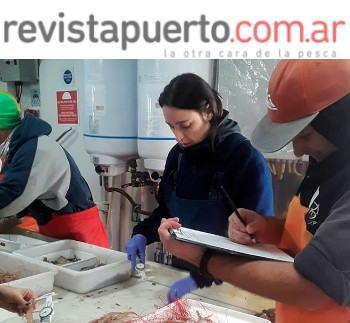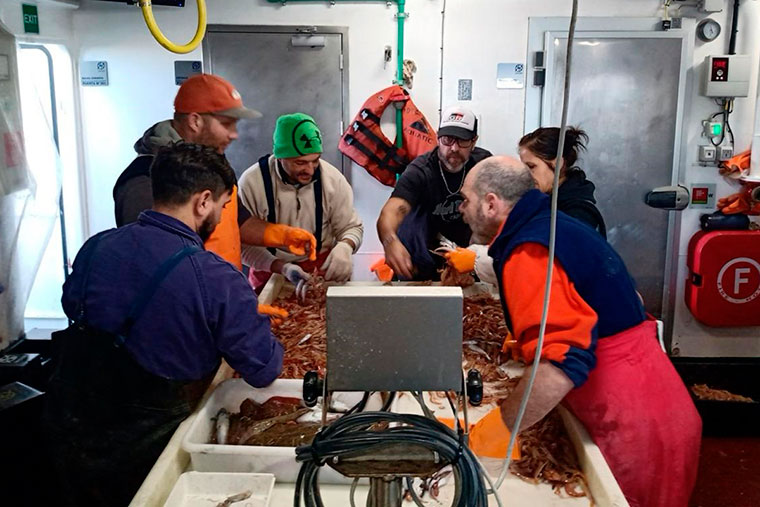|

Image: Revista Puerto / FIS
INIDEP Shrimp: 'The population, very slowly, is decreasing'
 ARGENTINA
ARGENTINA
Monday, February 12, 2024, 01:00 (GMT + 9)
INIDEP researchers assure this based on data collected throughout 2022 and part of 2023. It is not alarming, there is no overfishing or overexploitation, but the resource travels to an area of care. They are categorical in saying that it does not resist an increase in fishing effort. The reports cannot be accessed until released by the CFP.
.jpg)
Source: Stockfile FIS
Without a quorum in the Federal Fisheries Council because its members have not been appointed, access to the campaign reports or final evaluation of shrimp (Pleoticus Muelleri) cannot be had, given that it is this body that must release them for dissemination. This prevents the Program biologists from being able to update the actors in the sector about the evolution and changes in the fishery. Therefore, to know the general state of the resource and appealing to the data that can be disseminated, we interviewed researchers Paula Moriondo and Emiliano Pisani, in charge of the working group. The most relevant data was the slow but constant decrease in biomass that has been recorded. We talk about this topic, about the distribution of the resource and the logistical problems it generates, about the importance of having observers and about the possibility of more boats joining the fishery in this report.
REVISTA PUERTO: What is the status of the resource?
 PAULA MORIONDO: The general situation is good, we had already seen it in the March campaign. What we are seeing is that these fishing levels, these 200 thousand tons that they are fishing every year, what they are generating is that the population, very slowly, is decreasing. The shrimp is there, the concentrations are there and we also saw it in the last campaign, the shrimp is distributed, there are no striking things, when the reports are released the numbers will be known. In all models the state of the population is good, it is neither overfished nor overexploited. It is in a healthy state, with confidence intervals that go towards the areas of care. The population, little by little, is decreasing. They are not abrupt changes or something that scares us, because immediately the shrimp, with a small change in effort, with a favorable environment, can reverse the situation. PAULA MORIONDO: The general situation is good, we had already seen it in the March campaign. What we are seeing is that these fishing levels, these 200 thousand tons that they are fishing every year, what they are generating is that the population, very slowly, is decreasing. The shrimp is there, the concentrations are there and we also saw it in the last campaign, the shrimp is distributed, there are no striking things, when the reports are released the numbers will be known. In all models the state of the population is good, it is neither overfished nor overexploited. It is in a healthy state, with confidence intervals that go towards the areas of care. The population, little by little, is decreasing. They are not abrupt changes or something that scares us, because immediately the shrimp, with a small change in effort, with a favorable environment, can reverse the situation.
RP: What summary can be made of the 2023 season?
PM: It was a complicated season, first because of how the shrimp is distributed, the Rawson percentage increased a little compared to other years in terms of total landing, but very dispersed, a lot of wind, a lot of bad weather. The shrimp is dispersed, as we always say, the hake is in the middle and in 2023 many of the subareas that were suspended or closed were for hake, not for the shrimp. We are analyzing the data and the catch per unit of average effort that we calculate remains at the same levels, although a little less than in 2022, at a rate of 2,200 kilos per hour.
.png) <-- Source: Stockfile FIS <-- Source: Stockfile FIS
RP: Given what has been said, is this a level of effort at which the fishery can be maintained?
PM: Landings are maintained, 200,000 tons, but biomass estimates are telling us that the population is gradually decreasing.
RP: In 2021, a 27% drop in biomass was recorded and it remained at that level in 2022. Has that percentage increased?
PM: We did not do that calculation, because it was an average of the last five years. But, yes, the biomass is lower, although we still don't know by how much. It is a population trend, which is coming slowly.
RP: And what implication does this drop have?
PM: We always say that it is a population that responds a lot to fishing effort and if it maintains these levels of effort, it will continue, slowly, going downwards. But with changes in effort level it can improve. In 2023 there were fewer boats, in Rawson they started later and now they are fishing less due to circumstances that have nothing to do with the resource, because they were fishing well. They are all effortful regulations that helped the population improve again. We will surely see all of this reflected in the campaign. Let's find more out there, but we have to be careful, because this situation would arise because they didn't catch it. We have to see what is available and how all this that they are not fishing contributes to the population.

Source: Revista Puerto
RP: We were close to the Executive's decision to increase the number of boats in the fishery. Can the resource withstand an increase in fishing effort?
PM: No, no, no, because it is already showing that with these levels, slowly, the population is decreasing. Let's see what this year's March campaign tells us. Based on all the research we have, we believe that we are facing a species in which fishing effort is one of the greatest regulators. There is also that of the environment... In these short-lived species, the environment is also a trigger for changes, but more effort, we believe it cannot resist.
 RP: This year will the fleet encounter shrimp as dispersed as last year? RP: This year will the fleet encounter shrimp as dispersed as last year?
PM: The resource is already dispersed, it is not like before when there was monitoring from south to north, but it also depends on how the fishing is directed; This year it was aimed a lot at the southern subareas, which was where the most fishing was done. In the northern subareas the concentrations of the previous year were not found.
EMILIANO PISANI: The fleet also had contagious behavior; Where a group of boats found a concentration, all the boats went to fish there and exhausted those concentrations. So, if the dynamics are similar, perhaps this year we will see similar results.
RP: Last year there was a lot of complaint about the dynamics of openings and closings that complicated the operations of the freshers due to the time limits they have to travel away from the port. Is there a solution for this fleet?
.jpg) <-- Source: Stockfile FIS <-- Source: Stockfile FIS
PM: The fresh fleet that has entry and exit times this year was very complicated, but also because of the climate, because of the bad weather. And then it is affected depending on how the resource is distributed, if it is close to the coast it is easier for them and if the concentrations are further away they have greater difficulty in fishing. But the entry and exit times they have are not stipulated by us. That has to do with the quality of the product and is not something that we manage.
RP: How has the level of observer coverage been?
PM: In the tangoneros it was good, we had a lot of observers; many from the province, who are working extremely well and including a lot of quality information, but as always, the fresh fleet had little coverage. It is still very low.
EP: If there are areas where they are fishing alone, without freezers nearby and we do not have observers, we have no information and at some point this also affects them.
PM: We always ask for the same thing, because it is better for them. There are times when they are fishing in one quadrant and if the freezer data is bad, the entire quadrat is closed. And they say they are catching good shrimp, but if we don't have observers, we can't do anything, the entire subarea is closed as a precaution.
(4).jpg)
Source: Stockfile FIS
RP: Other data that is claimed and never obtained is that of Rawson's season. Was there any change with the new authorities?
PM: We still haven't had contact with them, today it is not a priority with all the problems that exist in the middle of the fishing season. But I think that when we can we will start talking. We hope that with the Chubut authorities we can work as we are working with the Río Negro authorities in the San Matías Gulf. We assume that when the Federal Council begins to function we will be able to raise it again.
Expanding knowledge

The Shrimp Program has always incorporated new researchers who have expanded the level of knowledge. Since last year, María Eugenia López joined, who is working on the development of a model to determine if there is interaction between shrimp abundance and environmental variables. What is sought is to develop mathematical models to determine if there is a relationship between salinity, temperature, depth, wind, etc., and abundance. If a relationship is established, these data could be a great contribution to understanding population dynamics.
Author: Karina Fernández | Revista Puerto (Translated from the original in Spanish)
.png)
[email protected]
www.seafood.media
|



